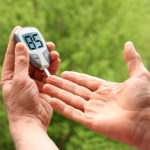 By James E. Grue, OD,
By James E. Grue, OD,
Ronald P. Snyder, OD, FAAO,
Michael J. Lipson, OD, FAAO, FSLS,
and Greg Caldwell, OD, FAAO
Nov. 3, 2021
Diabetes is a life-altering condition, which optometrists can help patients address as essential members of each patient’s care team. An important part of helping patients is asking questions that give you the information you need to encourage them to take ownership of managing their diabetes.
Impactful Conversations with Patients
This is the third article in the series, “Empowering the Patient.” In the first article, we explored two questions you should be asking your patients to help them gain greater control over their chronic conditions. We used diabetes management as an example to demonstrate how patient empowerment works:
1) “When you think about your diabetes, what worries you? What concerns about your diabetes keep you awake at night?”
2) “What challenges are keeping you from getting better control of your diabetes? What makes it difficult for you to improve your control? “
In the second article, we explored actual patient answers to the first question that was suggested you ask the patient. We explored how the answer to that question helps you identify and address the major concerns the patient may be facing in managing their condition.
In this article, we will look at the responses to the second question, “What challenges have you been having in getting better control of your diabetes?” The answers you receive to this question will tell you what needs to be in the plan of care to allow the patient to “own” the management plan and to adhere to it.
Building on Your Base of Information About the Patient
The answers to this second question will build on what you already know about the patient. You should have obtained a validated HbA1c on all patients with diabetes. In addition, during the history, your staff should still be asking the patient if they know their HbA1c value. The OD will learn a lot about the patient, and their condition, by knowing whether the patient knows their correct HbA1c value.
The other piece of information that you should have already received either directly from the patient’s primary care physician, or at least asked the patient is, “What is the plan of care to manage your diabetes that you and your primary care physician have in place?” The patient should be able to tell you the plan of care and how compliant they are in following it. Combining that information with the answers to this second question is going to provide a path to address the day-to-day issues the patient is facing.
What Patients Are Telling You
The following are examples of patient answers that providers got when they asked the second question. These answers are grouped into four different categories:
1) Patients who you have already had an effect on by addressing the answer to question #1
“I haven’t been taking control of my diabetes seriously enough, but I can see by what we just spoke about that I need to do a better job.”
Once you get this type of response to the second question, you have likely accomplished our goal of the visit, to empower the patient to think about their care in a different way. It may be better to reinforce that messaging and finish the exam at this point, instead of overwhelming the patient with additional information. Leave that to the next visit, but make that visit within a reasonable time period so you have continuity.
2) Patients who need to be referred for additional diabetes education
a. “I am constantly frustrated that I think I am doing what is right, but my HbA1c doesn’t get better.”
b. “Sometimes I make a meal that I think is healthy, and my glucose goes way higher than I expected.”
c. “It is so difficult cooking differently for one person in the family. A lot of times that simply doesn’t happen and I (or the person with diabetes) ends up eating what everyone else is eating.”
d. “I travel a lot for business and find it very difficult to eat correctly when traveling.”

To learn more: 844.393.3282. (toll free) or ContactUs@HealthCareRegistries.com
These questions can come in an almost endless number of ways, but they all indicate the patient needs more education to be an empowered patient. You also need to understand that delivering this level of education isn’t possible in your office and any attempts to do so will not have a significant effect on outcomes. This is where your participation with the patient care team opens new referral opportunities. These patients need to be referred to a diabetic educator.
You should have a relationship with the diabetic educators in your community and know how to make an appropriate referral. Diabetic educators follow a required best practice curriculum that involves 10 hours of education. Typically, when you refer a patient, the educator will have a phone conversation with the patient to determine how much of the 10 hours that particular patient needs, and will schedule appropriately.
This is also an opportunity for you to improve your relationships with primary care physicians. These patients present an excellent opportunity for you to let the physician know that you identified this need specifically to help the patient reduce their risk of developing retinopathy, and have made the referral. Diabetic educators can also be valuable referral sources.
3) Patients who need more motivation
“I know what to do, I just need to do a better job of eating and exercising correctly.”
“Sometimes I don’t pay enough attention to what I am eating.”
“I cheat too often.”
These patients present a clear opportunity for you to bolster your influence with them and the care team. The patient is telling you they need to be better motivated. It is hard being diabetic and difficult to get good control over it. Everyone wants that piece of cake for dessert, or to be able to eat anything they want when they go to a restaurant. The difference between the well-controlled patient and the poorly controlled patient is often the percentage of time their motivation is stronger than their impulse.
Other Articles to Explore
Losing vision is almost always one of the patient’s chief concerns. That positions you better than any other provider on the care team to address one of the issues that is most motivating to the patient. You are better prepared to address with the patient what they can do to reduce the risk of developing retinopathy, and potentially losing vision, than the primary care physician or any other provider on the patient care team. This is the patient with whom you want to spend considerable time helping understand the effect retinopathy can have on their eyes and vision.
In patients who do not yet have retinopathy, your conversation should be laser focused on what they can do to prevent the retinopathy, how you can monitor the microvascular changes that lead to retinopathy and the direct effect the HbA1c has on the risk of developing retinopathy.
It is important that you stress that your office will be analyzing the HbA1c trends and that information is available to the patient at any time. Similar to “weighing in” while on a weight loss program, studies show that data tracking is an important motivator for patients’ compliance.
In all cases, the level of effort you put into this education should be reported to the primary care physician. Your tracking of the risk through following the HbA1c is an ideal opportunity to improve your relations with the rest of the physicians on the care team by sending out quarterly reports on the outcomes that are occurring as a result of your efforts.
You should make an effort to ensure that you are invited, at least once a year, to present at the physician organization’s administrative meetings of providers. How the data from an outcome’s registry will help you do this is the topic of the next article in this series.
4) Patients that are struggling with Social Determinants of Health (SDOH)
“I try to eat healthy, but healthy food is so expensive. I simply can’t afford to eat healthy all the time.”
“I know what I am eating isn’t healthy, but it is all I can afford.”
“I work two jobs; both involve sitting at a computer. When I get home, I don’t have the energy or time to exercise.”
“I can hardly keep a roof over my head, let alone do the things I know I need to do to control my diabetes.”
These responses will come in many different forms and are going to be much more commonly heard if you practice in a community with a large under-served population.
These are challenges for the patient, everyone in healthcare, and for our society. At the present time, there isn’t much you can do but empathize with the patient and encourage them to do what they can. What you don’t want to do is place too high an expectation on a patient who is facing these challenges. A little improvement is better than none. It is better to have an HbA1c of 10 than it is of 12. Let them know that even small steps are better than none.
It is important for you to know that at the federal level this is one of the largest topics being addressed by the current administration. The Office of the National Coordinator of Health Information Technology (ONC) is aggressively working on integrating information on SDOH into electronic health records.
In the past, there have been several national level meetings dedicated to setting the interoperability standards to allow this information to be included in EHRs and in the exchange of patient health information. We aren’t too far away from the time when healthcare providers will be able to address these issues with the patient. This represents an expansion from team-based care to what is being called “community-based healthcare,” in which the resources of the community that affect health outcomes become part of the patient health information.
Once SDOH health have been built into EHRs, and when you get information from a Health Information Exchange (HIE) to begin your exam, you will get information including:
1. The bus schedules in your area to use with patients who have transportation challenges.
2. The food distribution, and what specifically is being distributed through food banks in the area. There is a national program to transition the extensive system that was put in place during the pandemic to a more targeted food distribution to help improve health outcomes.
3. Contact information on the area agencies that can help patients who are challenged with homelessness or potential homelessness.
4. You can expect to have access right within your EHRs to information on virtually every aspect of SDOH that you will be able to include in your plan of care.
You can see where our opportunities in managing diabetes, and many other chronic conditions, goes well past detecting whether diabetic retinopathy is present. We have the opportunity to completely change our interactions with the patient and the patient care team.
The first step in that transition is to ask the two questions presented in this series, and more importantly, listen to how the patient answers, and let those responses drive the patient care plan.
In the next article, we will address the importance of tracking the outcomes of the care you are delivering. We will explore the relationship between the answers to these same two questions with the measured outcomes that can be expected.
 James E. Grue, OD, is a health-care reform speaker and consultant. To contact him: JimGrue@HealthCareRegistries.com
James E. Grue, OD, is a health-care reform speaker and consultant. To contact him: JimGrue@HealthCareRegistries.com
 Ronald P. Snyder, OD, FAAO, is the president and CEO of HealthCare Registries, LLC. To contact him: RonSnyder@HealthCareRegistries.com
Ronald P. Snyder, OD, FAAO, is the president and CEO of HealthCare Registries, LLC. To contact him: RonSnyder@HealthCareRegistries.com
 Michael J. Lipson, OD, FAAO, is the chairman of the OrthoK Advisory Panel of HealthCare Registries, LLC.
Michael J. Lipson, OD, FAAO, is the chairman of the OrthoK Advisory Panel of HealthCare Registries, LLC.
 Greg Caldwell, OD, FAAO, is Chairman of the Advisory Panel for the Diabetes Management Registry.
Greg Caldwell, OD, FAAO, is Chairman of the Advisory Panel for the Diabetes Management Registry.

























